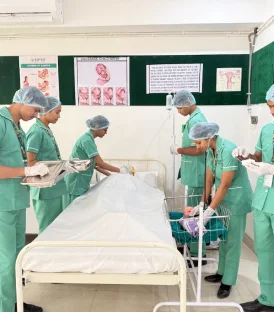May 26, 2023
A process of formation, development, and maturation of all types of blood cells which took
place in the bone marrow. This complete process is called haematopoiesis. The complex
system of production responds to the needs of the body to produce more cells. For Example
in hypoxia more red blood cells are produced, in acute infection more neutrophils are
produced.
Normal hematopoiesis is a process in which the generation of mature blood cells occurs from
a pluripotent stem cell though few in number, have extensive potential of proliferation.
The end products of this process are mature white blood cells (which provide our bodies with
protection from infection), mature red blood cells (which carry oxygen to the cells and tissues
in our bodies), and platelets (which help control bleeding.
All cellular elements are derived from a single unit called Haemopoietic Stem Cells (HSC). Its division consists of
- Erythropoiesis- Formation of Erythrocytes or Red blood cells.
- Leukopoiesis-Formation of Leucocyte or White blood cells.
- Thrombopoiesis-Formation of Thrombocyte or Platelets.
The sites of hematopoiesis vary from early foetal life to a child, there are three phases.
- Mesoblastic period
- Hepatic period
- Myeloid period
At 5-6months, the bone marrow starts taking over hematopoiesis, then bone marrow is the
principle site of blood formation.
In children, haematopoiesis occurs in the marrow of the long bones such as the femur and
tibia. In adults, it occurs mainly in the pelvis, cranium, vertebrae, and sternum.
Hemocytoblast (multipotential stem cell) is a common precursor for all series of blood cells.
The development of these cells takes place in 3 stages.
- Multiplication of precursor cells.
- Maturation.
- Release into blood circulation.
Developments of Blood cells.
The Stem cell divided into two parts.
- Common myeloid Progenitor
- Common Lymphoid Progenitor
Common myeloid progenitor cell are divided into-
– CFU (Colony forming unit) of Erythrocyte, Megakaryoblast, Myeloblast, and Mast cells.
Erythropoiesis-Developing stages of Erythrocytes are Pro Normoblast, Early Normoblast,
Intermediate Normoblast, Late Normoblast, Reticulocyte, and Erythrocyte.
Developing stages of Thrombocyte.
Thrombopoiesis occurs from common myeloid progenitor cells, which differentiate into
megakaryoblasts and then into megakaryocytes and then megakaryocytes break into small
cell fragment called Thrombocytes. Each megakaryocyte can produce 2000-3000
thrombocytes.
Developing stages of Myeloid series.
Myeloblast occurs from common myeloid progenitor cells, which differentiate into Pro-
myelocyte, Myelocyte, Metamyelocyte, Band form and then into segmented cells. These are
Neutrophils, Basophils, Eosinophils, and Monocytes.
Common Lymphoid Progenitor cells
Common lymphoid progenitor cells are the earliest lymphoid progenitor cells and give rise to
T-lineage cells, B-lineage cells, and natural killer (NK) cells.
From the common lymphoid Progenitor cell differentiate into Large lymphocyte (NK cells)
and small lymphocytes.
From the small lymphocyte differentiate into T lymphocytes and B lymphocytes.

















